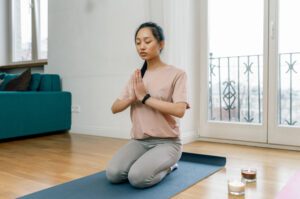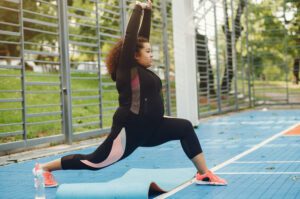What is the best type of yoga for me – Hatha, Vinyasa, Ashtanga?


Many people practice yoga and advocates of it will be quick to promote the many associated health benefits. So, what is yoga; what are the different types of yoga; and is their merit in the many health claims made?
What is yoga?
Yoga is an ancient and complex practice that originated in India more than 2000 years ago. Performed correctly, it encompasses union of the body with the state of consciousness, using physical postures (asanas), breathing techniques (pranayama), relaxation and meditation (dyana). It can take years to become proficient at performing some of the more complex moves; however, it is a form of exercise that can be adapted for all people, at all stages of life. It increases mindfulness and is claimed to improve both mental and physical health.
The different types of yoga
If new to the yoga experience, the many different types might seem confusing. It is true, yoga comes in many guises, with names that are unfamiliar to many of us. However, there are similarities between the different types and perhaps by knowing the basics, you will be better placed to pick a style that is best suited for you.
The below list is not exhaustive and some instructors may take a slightly flexible approach, encompassing different styles in their teaching; but, here are some of the most widely known yoga techniques:
- Hatha. This is a type of yoga that is focused on movement (in fact, many of the subtypes of yoga could be broadly classified as hatha). Participants are encouraged to execute their movements slowly, changing from standing, to sitting, to lying, in both prone and supine positions. Balance is fundamental as the movements predominantly involve remaining static for a period of time, before easing slowly into the next position. Integral yoga is a subtype of hatha that involves the same movements accompanied by chanting and meditation.
- Vinyasa. This is known as flow yoga as it involves continuous, dynamic movement from one posture to the next. It is faster moving and requires agility and coordination. As such, it may be better suited to those who are more experienced at yoga. It focuses on sun salutations (suryanamaskar) and the matching of one’s breathing to their movements.
- Ashtanga. This form of yoga was developed in the 1960s. It is a set series of poses that are performed in sequence. It is fast-paced, intense and flowing. It is one of the more physically demanding forms of yoga, requiring constant movement and regular practice.
- Iyengar. In this type of yoga, each position is held for a period of time, with the emphasis being on proper alignment and good posture throughout. It can be used for rehabilitation after injury.
- Bikram/hot yoga. A more recent addition to the yoga family, but very popular worldwide; this type of yoga involves a sequence of 26 hatha yoga postures combined with breathing exercises. It is performed in a temperature/humidity controlled environment at 35-42°C heat with 40–60% relative humidity. Advocates claim that the increased temperature loosens tight muscles and encourages the removal of toxins with enhanced sweating. Scientific studies struggle to find additional health-related benefits to this form of yoga, when compared to that performed at room temperature.
- Jivamukti. This is a physically intense form of yoga that combines ashtanga moves with chanting and periods of meditation. A session will often be focused around an inspirational theme and will include spiritual teachings.
- Kundalini. This type of yoga focuses on combining breathing techniques with specific physical movements.
- Viniyoga. This is an individualised approach to applying yoga teachings. Movements are adapted to suit each participant, depending on their stage of life and health status.
- Yin yoga. In direct contrast to those styles of yoga that are movement-oriented, this style involves holding poses for several minutes. The aim is to prepare the body to sit for a prolonged period of time in contemplative meditation.
Can yoga improve my health?
This question is surprisingly difficult to answer. There are many reported health benefits to undertaking yoga and those that practice it regularly, claim relief from a whole range of physical and emotional conditions. However, the evidence is surprisingly limited; very few studies have been performed, and those that have, are frequently poorly designed, making it a challenge to draw meaningful conclusions.
The conditions that yoga is said to improve include:
- Stress
- Insomnia
- Anxiety. Although this relates to coping with life situations, rather than medically diagnosed anxiety disorders, such as depression and PTSD.
- Diabetes/glucose tolerance
- Hypertension
- Neurodegeneration
- Coronary heart disease
- Chronic pain, specifically, that affecting the lower back.
It is claimed that yoga can help reduce obesity, by encouraging better eating habits and increasing the levels of physical activity. There is an association between yoga and lower BMI. People have also claimed that yoga has helped them to stop smoking by reducing their craving for a cigarette. It has been found to reduce some of the more difficult symptoms of the menopause, such as hot flushes and is recommended by some doctors as a non-drug approach to managing pain. Cancer patients, particularly those with breast cancer, use yoga to improve their quality of life.
Certainly, there is little to be lost by adding yoga to your routine. It comes with few risks (perhaps there are slightly more with Bikram yoga) and anecdotal evidence suggests that it can be very beneficial to a person’s state of mind as well as their physical wellbeing.
Nabta is reshaping women’s healthcare. We support women with their personal health journeys, from everyday wellbeing to the uniquely female experiences of fertility, pregnancy, and menopause.
Get in touch if you have any questions about this article or any aspect of women’s health. We’re here for you.
Sources:
- Cramer, Holger, et al. “Yoga for Improving Health-Related Quality of Life, Mental Health and Cancer-Related Symptoms in Women Diagnosed with Breast Cancer.” Cochrane Database of Systematic Reviews, 3 Jan. 2017, doi:10.1002/14651858.cd010802.pub2.
- Grabara, Małgorzata. “Could Hatha Yoga Be a Health-Related Physical Activity?” Biomedical Human Kinetics, vol. 8, no. 1, 22 Feb. 2016, pp. 10–16., doi:10.1515/bhk-2016-0002.
- Hunter, Stacy D., et al. “Effects of Yoga Interventions Practised in Heated and Thermoneutral Conditions on Endothelium-Dependent Vasodilatation: The Bikram Yoga Heart Study.” Experimental Physiology, vol. 103, no. 3, 18 Jan. 2018, pp. 391–396., doi:10.1113/ep086725.
- Mohammad, Ashu, et al. “Biological Markers for the Effects of Yoga as a Complementary and Alternative Medicine.” Journal of Complementary and Integrative Medicine, vol. 16, no. 1, 7 Feb. 2019, doi:10.1515/jcim-2018-0094.
- “Yoga: What You Need To Know.” National Center for Complementary and Integrative Health, U.S. Department of Health and Human Services, 15 May 2019, https://nccih.nih.gov/health/yoga/introduction.htm.










































